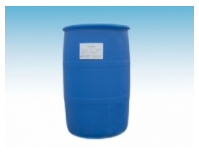In recent years, a new double chain quaternary ammonium salt disinfectant with one hydrophilic group and two lipophilic groups has been developed, which has a better gelling speed and a stronger ability to reduce the surface tension, and can increase their water solubility. Even in the case of high water hardness, it also shows a good solubility and good stability. The results showed that the bactericidal effect of double chain quaternary ammonium salt disinfectant was superior to that of single long chain quaternary ammonium salt, with better decontamination ability, low temperature resistance and toxicity. There are three kinds of new products on the market in China: Baidusha, also known as didecyldimethylammonium bromide; Xinjieling disinfectant, also known as didecyldimethylethylenediammonium bromide; lierkang 1210 disinfectant, a compound disinfectant composed of didecyldimethylammonium chloride and N-alkyl (50% C14, 40% C12, 10% C16) dimethylbenzylammonium chloride.
Its molecular structure can be divided into two parts: cation group and anion group. The cationic group is composed of four organic roots and nitrogen atoms, which is the effective part of sterilization. Most of the negative ions are halogen, sulfate or other similar negative ions. Quaternary ammonium salts, as disinfectants, generally have an alkyl group with a carbon chain of 8-18. If the carbon chain is shorter or longer than this range, the bactericidal ability is poor.

The common quaternary ammonium salt disinfectants in China mainly include: Bromogeramine (chemical name is dodecyl dimethylbenzyl ammonium bromide), Bromogeramine (dodecyl dimethylbenzyl ammonium chloride), Domiphen (also known as xiaoxining, chemical name is dodecyl dimethylphenoxyethyl ammonium bromide), xiaoxiaojing (tetradecyl-2-methylpyridinium bromide).
Using surfactant as carrier, iodine can be complexed with polyol ether or PVP under certain conditions, which is a widely used iodophor disinfectant. It can overcome the shortcomings of yellow dye and not easy to decolorize iodine. At present, it has become the first choice disinfectant for medical injection and hospital surgery.
Using the solubilization of detergents, phenols have been mixed with anionic surfactants for a long time. For example, Lysol disinfectant, i.e. coal phenol soap solution, is a compound of coal tar fractions (195 ℃ ~ 205 ℃) mainly composed of three cresol isomers (ortho, meta, para) and soap. The specific formula is: cresol 500ml, vegetable oil 173G, sodium hydroxide 27g, distilled water appropriate amount (full amount 1000ml). In preparation, soap is made from vegetable oil and sodium hydroxide, and cresol and distilled water are added while hot. The function of soap is to make cresol soluble in water and reduce the surface tension.